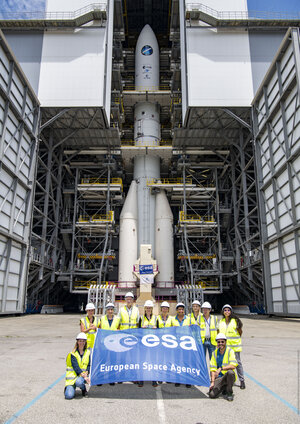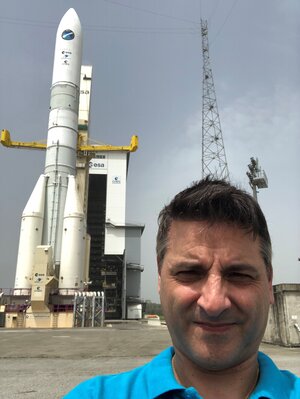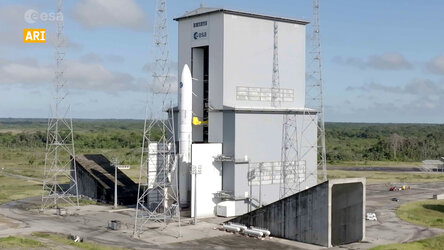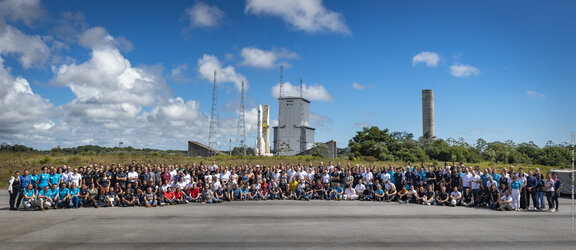Accept all cookies Accept only essential cookies See our Cookie Notice

About ESA
The European Space Agency (ESA) is Europe’s gateway to space. Its mission is to shape the development of Europe’s space capability and ensure that investment in space continues to deliver benefits to the citizens of Europe and the world.
Highlights
ESA - United space in Europe
This is ESA ESA facts Member States & Cooperating States Funding Director General Top management For Member State Delegations European vision European Space Policy ESA & EU Space Councils Responsibility & Sustainability Annual Report Calendar of meetings Corporate newsEstablishments & sites
ESA Headquarters ESA ESTEC ESA ESOC ESA ESRIN ESA EAC ESA ESAC Europe's Spaceport ESA ESEC ESA ECSAT Brussels Office Washington OfficeWorking with ESA
Business with ESA ESA Commercialisation Gateway Law at ESA Careers Cyber resilience at ESA IT at ESA Newsroom Partnerships Merchandising Licence Education Open Space Innovation Platform Integrity and Reporting Administrative Tribunal Health and SafetyMore about ESA
History ESA Historical Archives Exhibitions Publications Art & Culture ESA Merchandise Kids Diversity ESA Brand Centre ESA ChampionsLatest
Space in Member States
Find out more about space activities in our 23 Member States, and understand how ESA works together with their national agencies, institutions and organisations.
Science & Exploration
Exploring our Solar System and unlocking the secrets of the Universe
Go to topicAstronauts
Missions
Juice Euclid Webb Solar Orbiter BepiColombo Gaia ExoMars Cheops Exoplanet missions More missionsActivities
International Space Station Orion service module Gateway Concordia Caves & Pangaea BenefitsLatest
Space Safety
Protecting life and infrastructure on Earth and in orbit
Go to topicAsteroids
Asteroids and Planetary Defence Asteroid danger explained Flyeye telescope: asteroid detection Hera mission: asteroid deflection Near-Earth Object Coordination CentreSpace junk
About space debris Space debris by the numbers Space Environment Report In space refuelling, refurbishing and removingSafety from space
Clean Space ecodesign Zero Debris Technologies Space for Earth Supporting Sustainable DevelopmentLatest
Applications
Using space to benefit citizens and meet future challenges on Earth
Go to topicObserving the Earth
Observing the Earth Future EO Copernicus Meteorology Space for our climate Satellite missionsCommercialisation
ESA Commercialisation Gateway Open Space Innovation Platform Business Incubation ESA Space SolutionsLatest
Enabling & Support
Making space accessible and developing the technologies for the future
Go to topicBuilding missions
Space Engineering and Technology Test centre Laboratories Concurrent Design Facility Preparing for the future Shaping the Future Discovery and Preparation Advanced Concepts TeamSpace transportation
Space Transportation Ariane Vega Space Rider Future space transportation Boost! Europe's Spaceport Launches from Europe's Spaceport from 2012Latest

André in front of Ariane 6 test model
Thank you for liking
You have already liked this page, you can only like it once!
ESA's André da Silva, mechanical engineer and part of the Ariane 6 embedded team in front of the Ariane 6 test model at Europe's Spaceport. André is part of the embedded team so spends most of his time at ArianeGroup’s Les Mureaux site in France following the development of the structures for Ariane 6, working in the embedded team as the technical interface between the rocket’s prime contractor, Ariane Group, and ESA that is the procuring entity for the development of the Ariane launcher. He leads technical risk analyses for ESA, and provides technical support to the development process when needed.
The test model at Europe’s Spaceport in Kourou, French Guiana, stood 62 m high. It is exactly the same as the ‘production model’ Ariane 6 rockets that will soon be launched, except that its boosters do not need to be tested as part of the complete rocket, so the boosters are not fuelled.
Teams preparing Ariane 6 for its inaugural flight successfully completed for the first time a launcher preparation and countdown sequence, on 18 July 2023. Representatives of ESA, Ariane 6 prime contractor ArianeGroup and launch base prime contractor and test conductor CNES completed important objectives for system qualification and performed a series of actions fully representative of a launch chronology.
The launch simulation included the removal of the mobile gantry, the chill-down of ground and launcher fluidic systems, the filling of the upper and core stage tanks with liquid hydrogen (–253°C) and liquid oxygen (–183°C), and at the end of the test, the successful completion of a launch chronology up to the ignition of the Vulcain 2.1 engine thrust chamber by the ground system.
On 5 September 2023 the Vulcain 2.1 engine was ignited, fired for four seconds as planned and switched off before its liquid oxygen and liquid hydrogen fuels were drained to their separate underground tanks. The exercise showed again that the system can be kept safe in the event of a launch abort, as already demonstrated during the 18 July test.
A nighttime full-scale wet rehearsal for Ariane 6 was completed on 24 October 2023, the rocket was fuelled and then drained of its fuel. The test lasted over 30 hours with three teams working in shifts of 10 hours each.
A major full-scale rehearsal was conducted on 23 November 2023 in preparation for its first flight, when teams on the ground went through a complete launch countdown followed by a seven-minute full firing of the core stage’s engine, as it would fire on a launch into space.
A third combined test loading occurred on 15 December 2024 that included a launch countdown to qualify the launch system in degraded conditions and ensure its robustness in preparation for operations. This test sequence included qualification tests of several launch system functions in case of aborted launch and included one ignition of the Vulcain 2.1 engine thrust chamber. It was the fifth countdown run to include loading Ariane 6 with cryo-propellants since July.
-
CREDIT
MTA/IMA -
LICENCE
ESA Standard Licence

Ariane 6 ESA team with assembled test model on launch pad

Ariane 6 team with assembled test model on launch pad

Franck and Ariane 6 test model

Ariane 6 tests towards first flight















 Germany
Germany
 Austria
Austria
 Belgium
Belgium
 Denmark
Denmark
 Spain
Spain
 Estonia
Estonia
 Finland
Finland
 France
France
 Greece
Greece
 Hungary
Hungary
 Ireland
Ireland
 Italy
Italy
 Luxembourg
Luxembourg
 Norway
Norway
 The Netherlands
The Netherlands
 Poland
Poland
 Portugal
Portugal
 Czechia
Czechia
 Romania
Romania
 United Kingdom
United Kingdom
 Slovenia
Slovenia
 Sweden
Sweden
 Switzerland
Switzerland
























